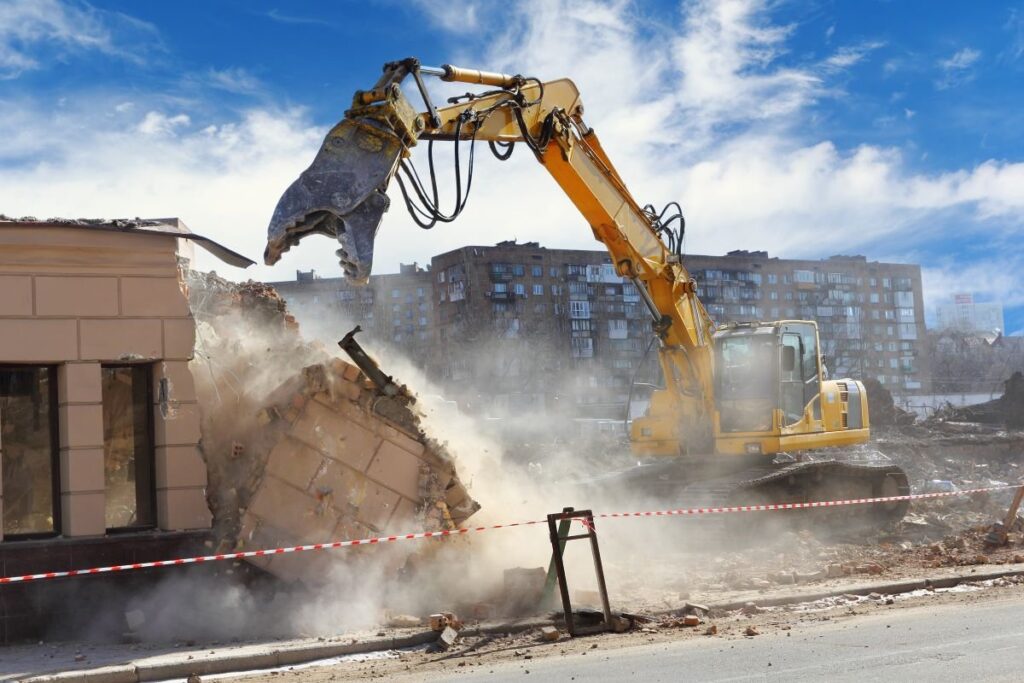Whether done manually or using mechanical methods, a demolition site exposes workers and the public to multiple risks, including falls, collapses, explosions, and fires. Property owners, contractors, and workers must follow specific demolition safety measures to ensure a safe demolition.
In this article, Excavation Chanthier’s experts delve into the key demolition safety measures for successful and accident-free projects.
Prioritize Demolition Safety Planning
Demolishing a building is not just about its physical destruction. It requires careful planning and preparation, for each step in the building demolition process.
OBTAINING A DEMOLITION PERMIT
If you plan to demolish an entire (or part of an) existing building in Quebec, it is mandatory to obtain a demolition permit or an authorization certificate and follow the Safety Code for the construction industry.
Before starting such a project, public authorities will evaluate whether or not to allow the demolition, based, among other things, on a report of the building’s general condition carried out by an expert.
CONDUCTING A TECHNICAL STUDY
A demolition project should be viewed as a reverse construction project. Regardless of the nature and scope of the project, the first step is always to conduct a thorough technical study.
The technical study assesses the structure conditions (floors, ceilings, facade, and other elements of the building) and identifies any existing safety issues. This study will also help define control measures to prevent any accidents during the work. Finally, it will identify the risks of partial structural collapse, health hazards (especially if the demolition involves a house containing asbestos), and fire risks.
Before the demolition company begins work, it is recommended that contractors and property owners have a written copy of the technical report.
DEVELOPING A SAFETY PLAN
During the project preparation phase, a safety plan must be developed to outline the various activities undertaken during the demolition. This plan should include details of the specific tasks to be performed, as well as an evacuation procedure in case of fire, and demolition safety measures.
A list of information containing the contact details of medical personnel, emergency services, and local authorities should be displayed and easily accessible to all workers on the project site.
PROTECTING AREAS SURROUNDING THE DEMOLITION SITE
Contractors and property owners must ensure that the necessary measures are in place to protect surrounding structures and areas during a demolition project.
For example, if the sidewalk next to the house demolition site is a high-traffic area, it may need to be blocked off or relocated to the street.
Additionally, it is important to ensure that the sidewalks and roadways in front of the building remain clear throughout the project.
To ensure the safety of road users, adequate lighting is also recommended in these areas and, if necessary, covering the sidewalks with shelters to protect pedestrians from falling debris.
Fences around the property are also advised to alert passersby that the area is dangerous.
SAFETY RISKS ON THE SITE
During a demolition project, it is essential to identify and pinpoint potential hazards inside the building. Here are some examples:
- Gas, water, or sewage pipes must be identified, and those affected by the project must be properly shut off.
- It is recommended to use a specific color code to identify public utility lines, so it is clear whether these lines should be removed or maintained during and after the demolition.
- All water tanks or underground reservoirs should be emptied.
- Holes in or around the structure should be identified and barricaded to prevent workers from tripping or falling inside.
Since fires pose a significant danger on demolition sites, portable fire extinguishers must be readily available and ready for use.
Additionally, all potential sources of fire must be identified and marked.
Proper protective clothing and equipment must be provided, such as eye, head, foot, and hand protection.
For large-scale demolition projects or those involving increased noise exposure, protective masks, and noise-reduction helmets should be included.
It is important to note that additional safety measures should be adopted if materials such as lead, asbestos, or silica are detected.
Partner with Demolition Safety Experts: EXCAVATION CHANTHIER
Demolition is a dangerous activity that requires careful planning and adequate demolition safety measures implementation, to prevent accidents.
By following these demolition safety measures and partnering with experienced demolition contractors like Excavation Chanthier, you can ensure a safe and successful demolition project. Our team is committed to prioritizing safety and adhering to industry best practices. Whether for garage demolition, pool demolition, or building demolition, we have the equipment and skills needed to carry out any type of demolition project safely.
Are you in the Montreal area and planning demolition work? Contact Excavation Chanthier today for a free quote.


